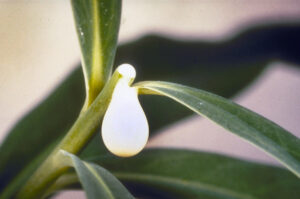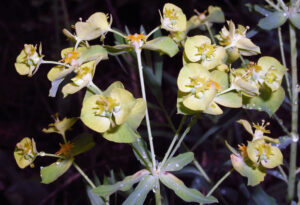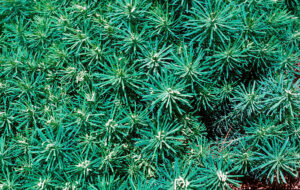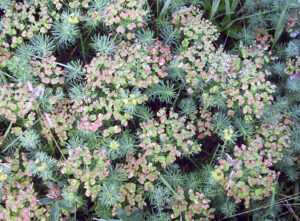By Erika Segerson-Mueller, DNR invasive plant program specialist, Oshkosh;
Erika.SegersonMueller@wisconsin.gov or 715-492-0391

The white milky sap of spurge plants, sometimes called “wolf’s milk,” can be toxic to cattle and irritating to human skin. / Photo Credit: Norman E. Rees, USDA Agricultural Research Service Retired, Bugwood.org
Managing invasive plant species can really be a pain. When the plants you are targeting can potentially harm human health, that pain can become quite literal.
Leafy spurge (Euphorbia esula) and Cypress spurge (Euphorbia cyparissias) are restricted invasive plants under Wisconsin’s Invasive Species Rule NR40. Aside from their tendency to spread aggressively and displace native species, both plants contain a white milky sap that can cause skin irritation in some humans and is potentially toxic to cattle and horses.
Why Worry About Leafy Spurge?
Although leafy spurge can now be found in most northern states, it was likely accidentally introduced to the Midwest in the early 1800s, possibly as a seed contaminant that arrived in oats. This plant is a rapid spreader; it invades open woods and can easily colonize forest openings.

The paired flowers of leafy spurge form umbels, or umbrella-shaped clusters, at the tops of stems. Below the clusters, leaves grow in whorls (radiating from one point). / Photo Credit: Leslie J. Mehrhoff, University of Connecticut, Bugwood.org
Extracts from the roots of leafy spurge roots leach into the soil wherever it grows and inhibit the germination and growth of other plants in the surrounding area. With deep root systems that are very troublesome to remove, leafy spurge is extremely difficult to eradicate.
One of the leafy spurge’s common names, “wolf’s milk,” describes the white milky sap found in both spurge species’ stems, flowers and leaves. This sap is distasteful to animals, can cause blistering in their mouths or throats and may be toxic to livestock. Skin irritation in humans can occur with varying effects from exposure to the sap, depending on the dose and species.
Outside of health effects, spurge species quickly create monocultures, exclude native vegetation and reduce wildlife habit value. They are especially aggressive in areas where soil moisture is limited, and there is less native plant competition.
Identifying Leafy Spurge
An herbaceous (soft and not woody) plant that can grow up to 4 feet tall, leafy spurge features simple, alternate leaves that are bluish-green in color, smooth and hairless with pointed tips. Flowers of leafy spurge bloom late spring through mid-summer and are small, yellowish-green and surrounded by cup-shaped bracts (modified leaves with flower clusters). The flowers are paired with 7-10 pairs, forming umbrella-shaped clusters at the tops of stems.
Seed capsules burst open when dry and disperse seeds explosively, landing as far as 15 feet away from the parent plant. This eruptive characteristic, along with hitchhiking on wildlife, humans and water, helps leafy spurge spread widely.

The leaves of cypress purge alternate on the stem and are narrow with pointed tips. / Photo Credit: John Ruter, University of Georgia, Bugwood.org
Controlling Leafy Spurge
Hand pulling or digging is effective only if the entire root system is removed. For specific chemical treatment recommendations and efficacy ratings, read the University of Wisconsin-Madison Extension leafy spurge management guide.
Identifying Cypress Spurge
Introduced as an ornamental ground cover in the 1860s, cypress spurge has been widely planted in cemeteries and is often called “graveyard weed.”
Cypress spurge plants are shorter than leafy spurge plants and grow only 6 to 12 inches tall. Cypress spurge has more leaves than leafy spurge, and many narrow leaves with pointed tips alternate along the stem. Below the blooming flowers, the leaves grow in whorls (leaves wrapping around the stalk or stem) and are hairless and bluish-green. Yellowish-green flowers in bracts turn purplish-red and are paired with 10-18 pairs clustered at the top of stems.
The roots of cypress spurge can extend down to 15 feet deep in the soil and spread up to 35 feet laterally. Root buds easily sprout, spreading the plant into undisturbed areas.
Controlling Cypress Spurge

Cypress spurge flowers have distinctive yellowish-green bracts that turn purplish-red. / Photo Credit: Leslie J. Mehrhoff, University of Connecticut, Bugwood.org
As with most invasives, repeated treatments are required. Continuous cutting and digging are needed to exhaust the extensive root reserves; as a result, that is not a recommended form of control. Foliar chemical treatment is more effective.
Confusing Look-alikes
The two spurges can also hybridize, causing confusion when identifying the species. Another look-alike is butter and eggs (Linaria vulgaris), which has leaves that can look very similar to those of leafy spurge. However, the snapdragon-like flowers of butter and eggs are very different than those of leafy spurge.
One Euphorbia species, flowering spurge (Euphorbia corollata var. corollata), is a native species with white flowers and leaves that attach to the upper stem in whorls, with multiple leaves coming off the same point.
Learn more about the spurges and additional regulated invasive species on the Wisconsin Department of Natural Resources Regulated Species webpage.
